The Intel Comet Lake Core i9-10900K, i7-10700K, i5-10600K CPU Review: Skylake We Go Again
by Dr. Ian Cutress on May 20, 2020 9:00 AM EST- Posted in
- CPUs
- Intel
- Skylake
- 14nm
- Z490
- 10th Gen Core
- Comet Lake
Core-to-Core Latency: Issues with the Core i5
For Intel’s Comet Late 10th Gen Core parts, the company is creating two different silicon dies for most of the processor lines: one with 10 cores and one with 6 cores. In order to create the 8 and 4 core parts, different cores will be disabled. This isn’t anything new, and has happened for the best part of a decade across both AMD and Intel in order to minimize the number of new silicon designs, and also to build in a bit of redundancy into the silicon and enable most of the wafer to be sold even if defects are found.
For Comet Lake, Intel is splitting the silicon such that all 10-core Core i9 and 8-core Core i7 processors are built from the 10c die, as is perhaps expected, and the 6-core Core i5 and 4-core Core i3 processors are built from the 6c die. The only exception to these rules are the Core i5-10600K/KF processors which will use the 10-core die with four cores disabled, giving six cores total. This leads to a potential issue.
So imagine a 10c die as two columns of five cores, capped on each end by the System Agent (DRAM, IO) and Graphics, creating a ring of 12 stops that data has to go through to reach other parts of the silicon. Let us start simple, and imagine disabling two cores to make an 8c processor. It can be pretty straightforward to guess the best/worst case scenario in order to get the best/worst core-to-core latency
The other worst 8c case might be to keep Core 0 enabled, and then disable Core 1 and Core 2, leaving Core 3-9 enabled.
We can then disable four cores from the original 10 core setup. It can be any four cores, so imagine another worst case and a best case scenario.
On the left we have the absolute best case arrangement that minimizes all core-to-core latency. In the middle is the absolute worst case, with any contact to the first core in the top left being a lot higher latency with more distance to travel from any core. On the right is an unbalanced design, but perhaps a lower variance in latency.
When Intel disables cores to create these 8c and 6c designs, the company has in the past promised that any disabling would leave the rest of the processor ‘with similar performance targets’, and that while different individual units might have different cores disabled, they should all fall within a reasonable spectrum.
So let us start with our Core i5-10600K core-to-core latency chart.
Cores next door seem well enough, then as we make longer trips around the ring, it takes about 1 nanosecond longer for each stop. Until those last two cores that is, where we get a sudden 4 nanosecond jump. It’s clear that the processor we have here as a whole is lopsided in its core-to-core latency and if any thread gets put onto those two cores at the end, there might be some questionable performance.
Now it’s very easy to perhaps get a bit heated with this result. Unfortunately we don’t have an ‘ideal’ 6c design to compare it against, which makes comparisons on performance to be a bit tricky. But it does mean that there is likely to be variation between different Core i5-10600K samples.
The effect still occurs on the 8-core Core i7-10700K, however it is less pronounced.
There’s still a sizeable jump between the 3 cores at the end compared to the other five cores. One of the unfortunate downsides with the test is that the enumeration of the cores won’t correspond to any physical location, so it might be difficult to narrow down the exact layout of the chip.
Moving up to the big 10-core processor yields an interesting result:
So while we should have a steadily increasing latency here, there’s still that 3-4 nanosecond jump with two of the cores. This points to a different but compounding issue.
Our best guess is that these two extra cores are not optimized for this sort of ring design in Comet Lake. For their Core lineup of processors, Intel has been using a ring bus as the principle interconnect between its cores for over a decade, and we typically see them on four and six core processors. Intel also used a ring bus in its enterprise processors for many years, with chips up to 24 cores, however those designs used dual-ring buses in order to keep core-to-core latency down. Intel has put up to 12 cores on a single ring, though broadly speaking the company seems to prefer keeping designs to 8 or fewer cores per ring.
If Intel could do it for those enterprise chips, then why not for the 10 core Comet Lake designs here? We suspect it is because the original ring design that went into consumer Skylake processors, while it was for four cores, doesn’t scale linearly as the core count increases. There is a noticeable increase in the latency as we move from four to six and six to eight core silicon designs, but a ten-core ring is just a step too far, and additional repeaters are required in the ring in order to support the larger size.
There could also be an explanation relating to these cores also having additional function on that section of the ring, such as sharing duties with IO parts of the core, or PCIe lanes, and as a result extra cycles are required for any additional cacheline transfers.
We are realistically reaching the limits of any ring-line interconnect for Intel’s Skylake consumer line processors here. If Intel were to create a 12-core version of Skylake consumer for a future processor, a single ring interconnect won’t be able to handle it without an additional latency penalty, which might be more of a penalty if the ring isn't tuned for the size. There's also a bandwidth issue, as the same ring and memory has to support more cores. If Intel continue down this path, they will either have to use dual rings, use a different interconnect paradigm altogether (mesh, chiplet), or move to a new microarchitecture and interconnect design completely.
Frequency Ramps
We also performed our frequency ramps on all three processors. Nothing much to say here – all three CPUs went from 800 MHz idle to peak frequency in 16 milliseconds, or one frame at 60 Hz. We saw the peak turbo speeds on all the parts.


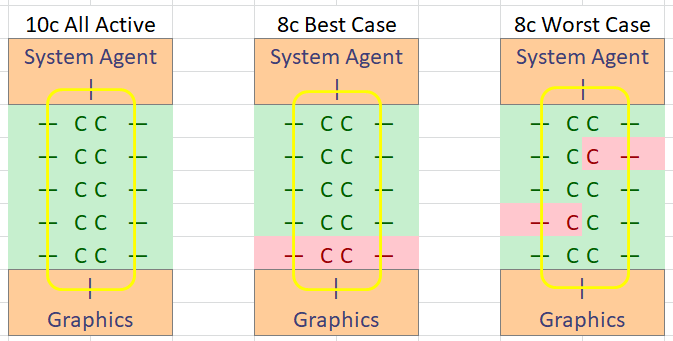
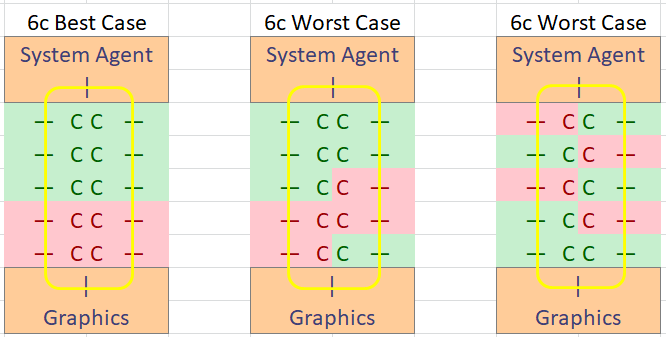
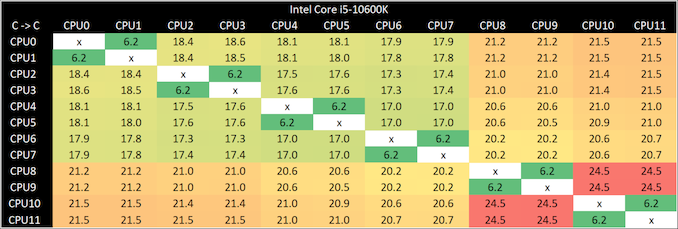



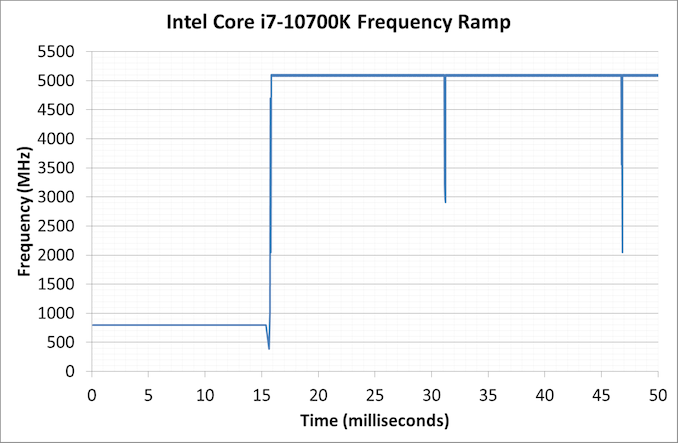
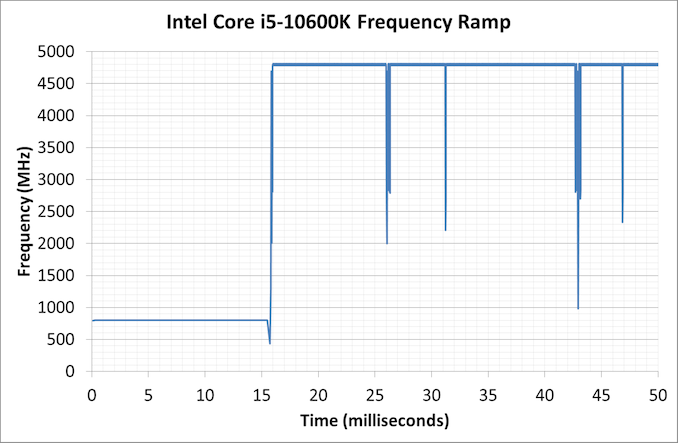








220 Comments
View All Comments
catavalon21 - Wednesday, May 20, 2020 - link
The ability to edit (or ^Z) would be most welcome, trust me.eastcoast_pete - Wednesday, May 20, 2020 - link
Isn't that Skylake running a bit dry by now? But, seriously, Intel really risks losing a lot of market share in future years by selling these "classics" at high prices, and that is if one can get one in the first place.Curious: how many commercial customers buy Intel desktops just because they have iGPUs, but want more CPU oomph than the 3200G has? Is that why Intel still dominates the OEM desktop market?
AnarchoPrimitiv - Wednesday, May 20, 2020 - link
Intel dominates the OEM market through intimidation and threats of retribution... They were literally convicted of bribing OEMs to NOT use AMD CPUs all throughout the 2000s in several courts around the world. The trials uncovered emails between Intel executives that stated, and I quote, "Dell is the best friend money can buy".... The proof is in the fact that currently, the Ryzen 4000 mobile CPUs are the best mobile chips offered right now, but Dell only puts them in the low end laptops. Why? Because Intel is probably giving huge financial incentives to bar AMD from premium designs to perpetuate the myth that AMD isn't a premium brandRetycint - Wednesday, May 20, 2020 - link
Do keep in mind that these are baseless speculations, based on something that happened 2 decades ago. Both Intel and AMD have changed since then (new engineering team, new management etc) and there has been no evidence of Intel providing incentives to cripple AMD systems. Go take your conspiracy elsewhere.And before you inevitably accuse me of being an Intel shill, this isn't about Intel or AMD, it's about facts to support your claim, of which there have been none
Irata - Wednesday, May 20, 2020 - link
Baseless speculation? Financial horsepower, MDF and meet the comp funds are current and no secret.Why do you think there are no Ryzen 4000 laptops with GPU above a 2060?
Spunjji - Tuesday, May 26, 2020 - link
Not entirely baseless, as they made two distinct claims. I've been a party to how Intel's "Marketing Development Funds" work - and work it does, at all levels from OEM to reseller to retailer. These days they don't explicitly punish anyone for not buying AMD - they simply tie rebates that will improve the profit margins on a product to specific quantities of those products being sold. It's "nobody's fault" if those quantities happen to make the sale of an AMD product by a given retailer or reseller distinctly unlikely.As for incentivizing bad *builds* of AMD systems, though, I'm not so sure. Intel clearly do a lot of work building reference platforms, and the economics of doing integration testing for a new vendor is not trivial. Honestly though, it's hard to tell how we *would* know if this were going on, because it would absolutely be made to look innocent - just like last time.
brantron - Wednesday, May 20, 2020 - link
"literally convicted of bribing"1) No. That's not what "literally" means.
2) No. No one was even *charged* with a crime, much less convicted.
3) No. It wasn't about bribery.
The reason Athlon 64s weren't ubiquitous way back when is the same reason the 4000 APUs aren't today - there aren't enough to go around.
If your post were to be rephrased without hyperbole, baseless accusations, and whataboutism unrelated to the topic of this article, it would read something like this:
"6 months after AMD's announcement of Renoir, the number of 4000 APUs sold for desktops is literally zero (see how that works?) because TSMC is still slammed."
WaWaThreeFIVbroS - Thursday, May 21, 2020 - link
Your ignorance is amusingIt is technically a bribery
https://www.extremetech.com/computing/184323-intel...
Spunjji - Tuesday, May 26, 2020 - link
First 3 points: accurate, if not entirely on-topic. Nobody was charged with a crime, but Intel sure were fined a lot for collusion.Which gets to the 4th point: again, accurate, but not entirely relevant. AMD were definitely not able to match Intel for manufacturing, which is why they couldn't have beaten Intel out of the market entirely, but that was barely related to why they weren't getting into Dell systems. See the aforementioned proven-and-fined-for collusion.
drothgery - Friday, May 22, 2020 - link
Or because premium designs take longer when the new chip isn't just another respin of the same thing, and AMD hadn't produced a viable high-end notebook chip in well over a decade so it made sense to wait and see if Ryzen 4000 was any good rather than designing in advance?